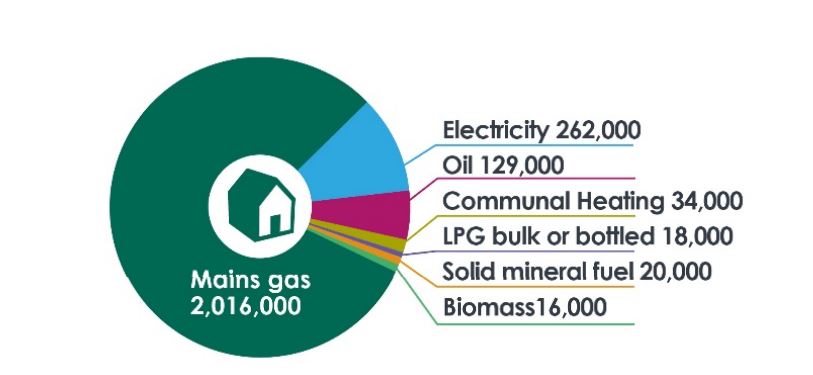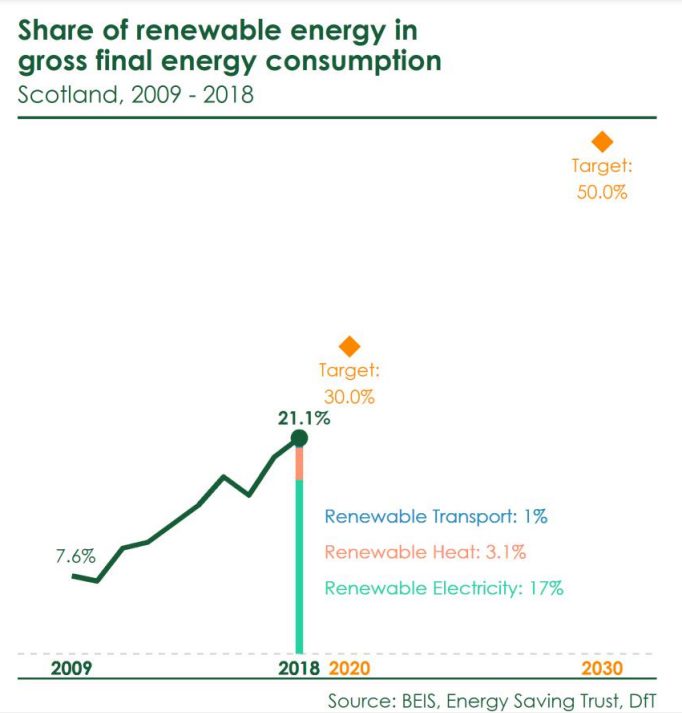Low Carbon Energy
How can we increase the productivity of our energy use and generate energy without greenhouse gas emissions?
The Challenge
Scotland’s electricity system is now largely powered by renewables. Technology innovations could see the electricity sector remove more CO2 from the environment than it produces, for example, using bioenergy for electricity generation combined with carbon capture and storage.
Over the past 20 years Scotland’s electricity system has become far less carbon intensive and is now predominantly powered by renewables. But electricity is only one part of the energy we use; in Scotland we use a considerable amount of energy for heating and for transporting goods and people.
The Scottish Energy Strategy sets a target for the equivalent of 50% of heat, transport and electricity consumption to come from renewable sources by 2030.
To make this happen we have to take a whole system approach, increase the productive use of the energy we generate and reduce the reliance on fossil-fuelled energy in homes, transport and industry.
- Increasing the productivity of our energy use
- Net zero emission heating
- Producing low carbon energy
- Storing and distributing energy
Read Scottish Energy Strategy: The Future of Energy in Scotland
Watch the short video ‘Where does our electricity come from?’ put together for the Scotland’s Climate Assembly
Read more about Scotland’s Climate Assembly
Increasing the productivity of our energy use
Increasing the productivity of our energy use reduces the amount of energy individuals and businesses need to buy, which is a win-win situation.
Heat is a key issue. Heat in buildings accounts for 20% of Scotland’s greenhouse gas emissions. The Climate Change Plan update estimates that around 50% of homes and non-domestic buildings will need to convert to a low or zero emissions heating system by 2030.
Watch CXC researcher Jan Webb discuss emissions from our homes in this video for Scotland’s Climate Assembly
Scotland has a relatively large proportion of poor quality building stock in terms of its energy efficiency and fuel poverty remains a major problem.
A new Heat in Buildings Strategy will update the Energy Efficient Scotland route map, and will commit to putting in place standards and regulation for heat and energy efficiency, with the aim of all buildings being energy efficient by 2035 and use zero emission heating and cooling systems by 2045.
Net zero emission heating
Reducing emissions from our homes and buildings is one of the most important things we can do to help end Scotland’s contribution to climate change.
The Scottish Government’s Heat in Buildings Strategy sets out a path to ‘transform our buildings and the systems that supply their heat, ensuring all buildings reach zero emissions by 2045.’
The aim is to make Scotland’s homes and workplaces warmer, greener and more efficient.
Most Scottish homes use mains gas for heating, as shown in the following figure showing the number of homes using each primary heating fuel:

Source Scottish House Condition Survey, 2019
Read the Heat in Buildings Strategy – achieving net zero emissions in Scotland’s buildings
Producing low carbon energy
While renewable technologies have changed how we generate electricity, changes across heating and transport have been much slower.
How much of the energy or heat and transport can come from electricity? What other sources could we use?
There are also issues around how people, as consumers, interact with new technology, such as electric cars or heat pumps in homes. This has not been a consideration in switching to electricity generated from renewables.

Source Annual Compendium of Scottish Energy Statistics 2020
Storing and distributing
A secure and flexible energy system needs storage capacity and resilient transmission.
Traditionally the UK has stored energy in the form of coal stocks at power stations and natural gas in pipelines.
What impact will new modes of energy generation have on the flexibility to deal with changing demand across days and seasons?
What is the potential for integrating storage across the whole energy system?

Source: Annual Compendium of Scottish Energy Statistics 2020
Our Response
While Scotland can learn much from low carbon developments internationally, technologies are more or less efficient in different places.
Local social and cultural norms; the particularities of governance, business models and consumer trust are all important factors. Scotland needs to find the solutions that can deliver locally.
Across all energy issues we focus on bringing together technical and socio-economic insights and evidence. Decarbonising heat is a challenge we look at across all aspects of our energy policy.
- Increasing the productivity of our energy use
- Net zero emission heating
- Producing low carbon energy
- Storing and distributing energy
Increasing the productivity of our energy use
We are looking at the challenges of increasing uptake of existing energy efficiency technologies, and developing smarter ways to use less energy through digital technologies and social behaviours.
Featured projects
Net zero emission heating
Using hydrogen for heating, heat pumps and other technologies can help heat our buildings in a greener way. We are supporting policy development looking at the current situation and the most cost effective options to transform heating.
Featured projects
Producing low carbon energy
Key issues for our research are understanding how cost reductions work for different technologies, the supply chain potential, and ways in which local projects can deliver value locally and across the whole energy system.
Featured projects
Storing and distributing energy
Looking for the possible technical solutions for energy storage and transmission has to be balanced with analysing the impact on Scotland’s energy sector – as part of the UK – of international developments across legislation and trade in energy.
Featured projects